George Dayton created Target Corporation in Minneapolis, Minnesota, in 1902, initially as Goodfellow Dry Goods.
Target did not open its first shop until 1962, when it established itself as a cheap retailer. As the firm developed, it became critical to provide a competitive compensation and benefits package to attract and retain personnel.
1970s-1980s: Establishing Foundations
Target quickly grew across the United States in the 1970s and 1980s. This time witnessed the implementation of fundamental wage and benefit policies. Initially, the emphasis was on offering competitive pay and essential perks like as healthcare and retirement plans. Target sought to separate itself from rivals by providing somewhat higher pay rates and more extensive benefit packages.

1990s: Enhancing Employee Benefits:
Target swiftly grew across the United States in the 1970s and 1980s. This time witnessed the implementation of fundamental wage and benefit policies. Initially, the emphasis was on offering competitive pay and basic benefits like as healthcare and retirement programs. Target tried to set itself apart from rivals by providing somewhat higher pay rates and more complete benefit packages.
2000s: Focus on Work Life Balance:
The 2000s saw a move towards better work life balance for Target workers. The corporation began giving paid time off (PTO), which includes vacation, sick leave, and personal days. Target has started emphasizing flexible work hours and family friendly practices, such parental leave and daycare help. This decade also witnessed the advent of educational support programs, which helped workers improve their studies and enhance their careers.
2010s: Increasing Wages and Expanding Benefits:
Target made considerable progress in the 2010s, raising their minimum wage many times. In 2017, the corporation announced a goal to increase the minimum hourly salary to $15 by the end of 2020, which was completely implemented. Along with compensation increases, Target increased its benefits to include better healthcare alternatives, mental health assistance, and more financial wellness initiatives.
2020s: Adapting to New Challenges:
The 2020s presented new concerns, notably with the start of the COVID 19 pandemic. Target reacted by instituting a variety of employee supportive initiatives, including increased paid sick leave, incentives for frontline workers, and better store safety practices. The corporation also increased its remote work policy and continues to reinvent its benefit packages to meet the changing demands of its personnel.
Current Pay and Benefits Structure
Today, Target’s compensation and benefits package is intended to attract and maintain a diverse and competent staff. Key components are:
- Competitive Wages: The minimum hourly rate is $15, with opportunities for greater pay depending on job and location.
- Health and Wellness: We provide comprehensive health insurance coverage, mental health services, and wellness programs.
- Financial Security: Financial security includes 401(k) retirement plans with employer matching, stock purchase programs, and financial counseling.
- Work life Balance: Includes paid time off, parental leave, flexible work schedules, and childcare assistance.
- Career development: Includes educational support, training programs, and possibilities for growth within the firm.